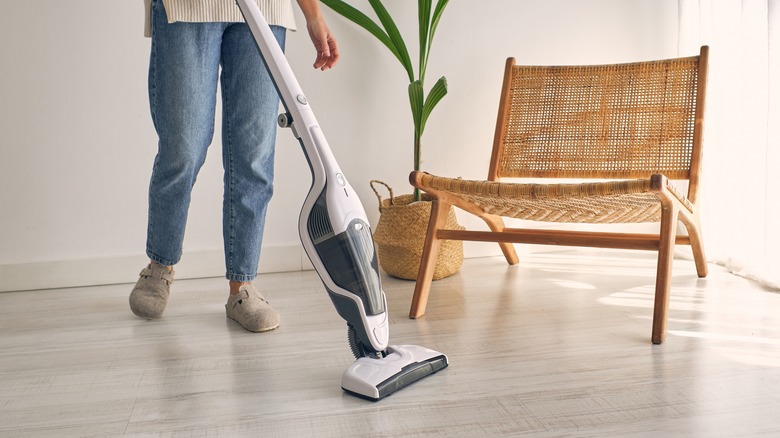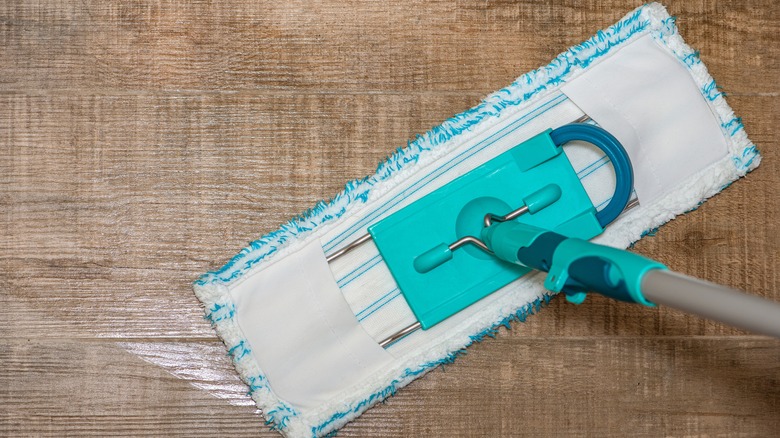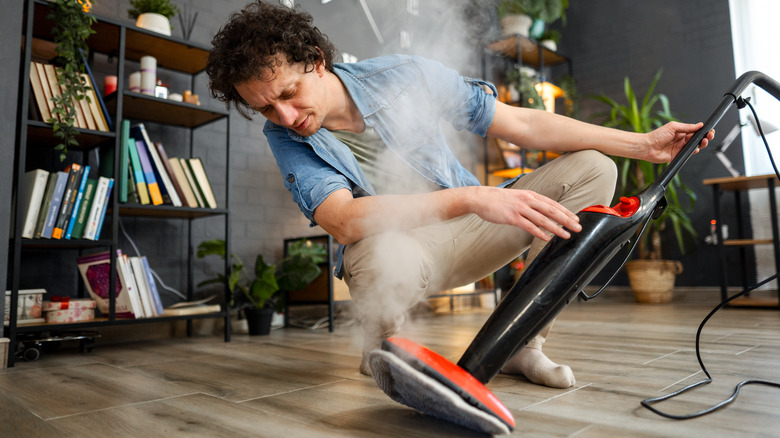The Flooring Material That's The Easiest To Clean
Vinyl flooring stands out as one of the easiest types of flooring to clean due to its inherent qualities and characteristics. To start, vinyl is highly resistant to water and moisture, making it ideal for areas prone to spills or high humidity. Unlike materials like hardwood or carpeting, vinyl won't warp or absorb liquids, simplifying cleanup significantly. This resilience makes it suitable for spaces like kitchens and bathrooms, where spills are common. Another advantage of vinyl flooring is its smooth, non-porous surface. Unlike grouted tiles or textured materials, vinyl doesn't harbor dirt, dust, or bacteria in crevices or uneven surfaces. This smoothness facilitates effortless sweeping, mopping, or vacuuming, requiring minimal effort to maintain cleanliness. Additionally, vinyl's resistance to stains ensures that spills can be quickly wiped away without leaving behind permanent marks or discoloration.
Furthermore, vinyl flooring is durable and scratch-resistant, minimizing the risk of damage from everyday foot traffic or accidental impacts. Unlike delicate surfaces like hardwood or laminate, vinyl can withstand frequent cleaning without showing signs of wear and tear. This durability translates to long-term cost savings and easier maintenance over the lifespan of the flooring.
Overall, these qualities make vinyl flooring a practical choice for households seeking low-maintenance flooring solutions that can withstand the rigors of daily use without sacrificing cleanliness or aesthetic appeal. You may particularly want to consider vinyl flooring if you have pets or small children, as it can stand up to the frequent accidents, filth, and spills associated with them.
How to clean vinyl flooring
To clean vinyl flooring properly, start by sweeping or vacuuming the surface to remove any loose dirt, dust, or debris. Use a soft-bristled broom or a vacuum cleaner with a hard floor setting to avoid scratching the vinyl. Pay attention to corners and edges where dirt tends to accumulate. After sweeping or vacuuming, prepare a cleaning solution appropriate for vinyl flooring. A mixture of warm water and a mild detergent or vinyl floor cleaner is suitable. Avoid using harsh chemicals or abrasive cleaners that could damage the vinyl surface.
Dampen a mop or microfiber cloth with the cleaning solution, ensuring it is not overly wet. Wring out the mop or cloth thoroughly before starting to clean. Begin mopping the vinyl flooring, working in small sections to ensure thorough coverage. Use gentle, circular motions to lift dirt and stains from the surface. Pay attention to any stubborn spots or spills, applying slightly more pressure if needed. Once you've mopped the entire floor, rinse the mop or cloth with clean water and go over the vinyl flooring again to remove any remaining soap residue. Alternatively, you can use a clean, damp mop or cloth for this final rinse.
Finally, allow the vinyl flooring to air dry completely before walking on it again. Avoid walking on wet vinyl to prevent slips and to allow the floor to dry evenly. If desired, you can speed up the drying process by using a fan or opening windows for ventilation.
Precautions for cleaning vinyl floors
When cleaning vinyl floors, it's essential to exercise caution to avoid damaging the surface. One common mistake is using harsh chemicals. Avoid using cleaning agents containing ammonia or bleach on vinyl floors, as these can cause discoloration, surface damage, or stripping of the protective layer. Instead, opt for mild detergents specifically formulated for vinyl flooring or products recommended by the manufacturer. Similarly, abrasive cleaning tools, like steel wool or stiff-bristled brushes, should be avoided when cleaning vinyl floors. These tools can scratch or gouge the surface, leading to permanent damage. Instead, use soft-bristled brooms, microfiber mops, or gentle scrubbing pads designed for use on vinyl surfaces. These tools effectively lift dirt and grime without causing harm.
Another precaution is to avoid excessive water when cleaning vinyl floors. While vinyl is water-resistant, excessive moisture can seep into the seams or edges of the flooring, causing warping, lifting, or mold growth. Use a damp mop or cloth rather than soaking the floor, and be sure to thoroughly wring out excess water before cleaning. Promptly wipe up any spills to prevent water from sitting on the surface for an extended period.
Finally, it's important to avoid using steam cleaners on vinyl floors. While steam cleaners are effective for cleaning many surfaces, the high heat and moisture can damage the adhesive holding vinyl tiles or planks in place. Instead, stick to traditional cleaning methods using gentle detergents and tools specifically designed for vinyl flooring.


